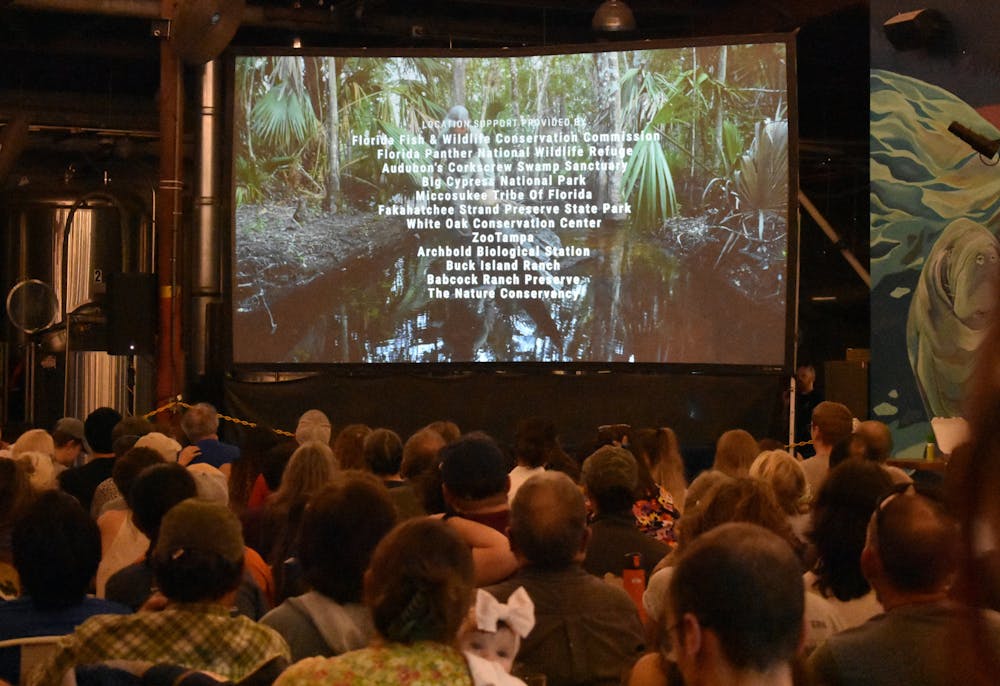When Sierra Scauzillo, a 24-year-old wildlife technician, lived in south Florida, she would wake up to the songs of the Eastern Meadowlark.
Hearing their calls in “Path of the Panther” — a 2022 documentary exploring the struggles of the Florida panther and its habitats — was the first time she had heard them since coming back to Gainesville.
“I grabbed [my boyfriend’s] hand and said, ‘I’m home again,’” Scauzillo said.
She admired how the film made individuals feel like they can make a change, and that it reminded audiences that they have an impact on this larger species that has an impact on them, she said.
Around 200 people packed into First Magnitude Brewing Company Wednesday to watch “Path of the Panther,” a film directed by Emmy-winning director Eric Bendick and produced by National Geographic photographer Carlton Ward Jr.
The audience, consisting of babies, children, college students and adults quickly filled the brewery and overflowed onto the deck. Audience members sat on chairs, benches, stools, lawn chairs and the fence of the deck itself, along with some members standing against the walls. The air was warm, the drinks were cold.
The inside of the brewery, lined with a color mural of Florida wildlife done by Jenna Horner, set the scene for this documentary. The film showed the Florida panther, among other Florida wildlife, in its natural habitat.
The film took about six years to make and is currently showing in theaters across the state. It will also be released on Disney+ and the National Geographic Channel around Earth Day this year. The screening was followed by a Q&A of members of the team that made the film.
One of those members, Malia Byrtus, 27, worked on the film as a camera trap technician, meaning she set up cameras to stay out in the panther habitats so that they could have undisturbed footage of the panthers without the presence of humans.
“Florida’s wildest places are hidden in plain sight,” she said. “We still have habitats that are equivalent to the Peruvian Amazon, or places that you see in these nature documentaries — we still have that here in the state. And it's worth protecting. We still have the time to protect them before they're gone.”
In addition to just the lives of Florida Panthers, the documentary focuses on the Florida Wildlife Corridor — a network of about 18 million acres of protected lands and private, unprotected working lands— and the efforts made to protect it.
In 2021, the Florida Wildlife Corridor Act was passed unanimously to protect the corridor, giving about $400 million for its protection. As of now, about 10 million acres are protected.
This film shows how the movement to protect Florida wildlife is bipartisan and requires support from all communities, Byrtus said.
For Byrtus, the best part of the production was setting up the cameras alone in the wild. She would be working so quietly that she could hear the sounds of black bears, alligators and other wildlife. While it took a little time to get comfortable, she eventually was able to recognize individual animals she had seen on the camera when she went into the wild.
Byrtus knows that when talking about environmental conservation, you have to reach people’s minds and their hearts, which is best done through film and photography. This medium allows viewers to feel the energy from the environment they are seeing.
“The aspect of sound is something people think a lot about, like hearing those noises,” she said. “What a panther sounds like, what an alligator sounds like. Those are things not everyone knows. So, through film a lot of people can experience that.”
Joe Guthrie, a wildlife biologist at Archbold Biological Station who worked on the film, said nothing gets people’s attention like a film.
“This film has so many take-your-breath-away moments in this film,” he said. “No one has seen Florida panthers like this before. Hasn’t happened in human history.”
The power in “Path of the Panther” is not only the stories of wildlife, but also the human stories woven into it. The film, like nature itself, cannot separate humanity’s connection to wildlife.
The underlying message of the film is how people’s ambition and vision for their own futures, whether they are a landowner or a rancher, will inspire them to see that “it’s the land we all have in common,” Guthrie said, referencing poet and farmer Wendell Berry’s famous line: “The Earth is what we all have in common.”
Despite a divisive political landscape, in Florida the conservation movement has seen bipartisan support. This unity has helped make progress in protecting the corridor, but there is still a long way to go.
“It's been a political football for the better part of the last decade because there hasn't been enough pressure on our lawmakers to actually spend that money on conservation,” he said. “But now with the passage of the Florida Wildlife Corridor Act, there is a plan.”
Contact Lauren at lwhiddon@alligator.org. Follow her on Twitter @LaurenWhid.
Lauren Whiddon is a UF journalism senior and the multimedia editor. When she's not writing she is updating her Letterboxd account or reading classic literature.






